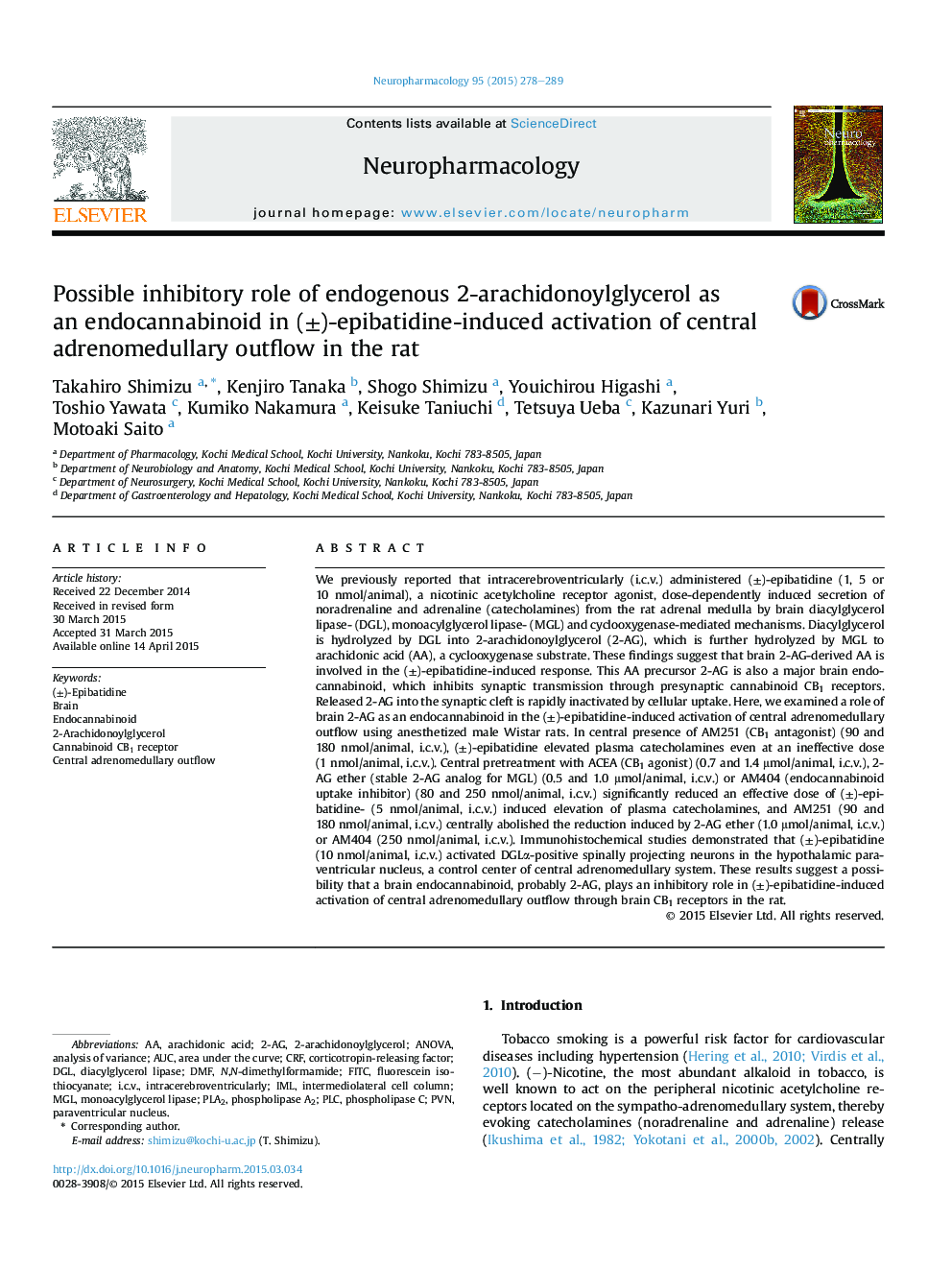| کد مقاله | کد نشریه | سال انتشار | مقاله انگلیسی | نسخه تمام متن |
|---|---|---|---|---|
| 5813690 | 1556619 | 2015 | 12 صفحه PDF | دانلود رایگان |

- Brain CB1 antagonism potentiated (±)-epibatidine-induced catecholamines' elevation.
- Brain CB1 agonism reduced the (±)-epibatidine-induced elevation.
- Endocannabinoid uptake inhibition reduced the (±)-epibatidine-induced elevation.
- The inhibition-induced response was dependent on brain CB1 receptors.
- (±)-Epibatidine activated spinally projecting PVN neurons expressing DGLα.
We previously reported that intracerebroventricularly (i.c.v.) administered (±)-epibatidine (1, 5 or 10 nmol/animal), a nicotinic acetylcholine receptor agonist, dose-dependently induced secretion of noradrenaline and adrenaline (catecholamines) from the rat adrenal medulla by brain diacylglycerol lipase- (DGL), monoacylglycerol lipase- (MGL) and cyclooxygenase-mediated mechanisms. Diacylglycerol is hydrolyzed by DGL into 2-arachidonoylglycerol (2-AG), which is further hydrolyzed by MGL to arachidonic acid (AA), a cyclooxygenase substrate. These findings suggest that brain 2-AG-derived AA is involved in the (±)-epibatidine-induced response. This AA precursor 2-AG is also a major brain endocannabinoid, which inhibits synaptic transmission through presynaptic cannabinoid CB1 receptors. Released 2-AG into the synaptic cleft is rapidly inactivated by cellular uptake. Here, we examined a role of brain 2-AG as an endocannabinoid in the (±)-epibatidine-induced activation of central adrenomedullary outflow using anesthetized male Wistar rats. In central presence of AM251 (CB1 antagonist) (90 and 180 nmol/animal, i.c.v.), (±)-epibatidine elevated plasma catecholamines even at an ineffective dose (1 nmol/animal, i.c.v.). Central pretreatment with ACEA (CB1 agonist) (0.7 and 1.4 μmol/animal, i.c.v.), 2-AG ether (stable 2-AG analog for MGL) (0.5 and 1.0 μmol/animal, i.c.v.) or AM404 (endocannabinoid uptake inhibitor) (80 and 250 nmol/animal, i.c.v.) significantly reduced an effective dose of (±)-epibatidine- (5 nmol/animal, i.c.v.) induced elevation of plasma catecholamines, and AM251 (90 and 180 nmol/animal, i.c.v.) centrally abolished the reduction induced by 2-AG ether (1.0 μmol/animal, i.c.v.) or AM404 (250 nmol/animal, i.c.v.). Immunohistochemical studies demonstrated that (±)-epibatidine (10 nmol/animal, i.c.v.) activated DGLα-positive spinally projecting neurons in the hypothalamic paraventricular nucleus, a control center of central adrenomedullary system. These results suggest a possibility that a brain endocannabinoid, probably 2-AG, plays an inhibitory role in (±)-epibatidine-induced activation of central adrenomedullary outflow through brain CB1 receptors in the rat.
Journal: Neuropharmacology - Volume 95, August 2015, Pages 278-289